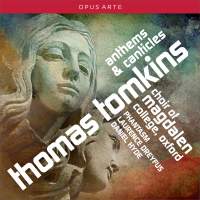Texte paru dans: / Appeared in: |
|
|
Reviewer: Barry
Brenesal
This album is
very similar in structure to another entitled These Distracting Times,
released in 2009 and reviewed by J. F. Weber (Obsidian 702; Fanfare 33:1).
That disc featured a mix of pieces for viol consort, anthems and canticles
for choir (with and without viol consort), and works for solo organ. David
Skinner led Alamire and the Choir of Sidney Sussex College, Cambridge. Our
current release features an identical mix of textures (the album itself is
entitled Anthems & Canticles), save that the choral works were all composed
for accompaniment by viol consort, along the lines of many accompanied
English songs published in Tomkins’s youth. Fretwork only performs three
selections and the Sidney Sussex Choir, 12, under Skinner. On this release,
the division of labor is spread identically, with seven cuts allocated to
Phantasm by itself, and seven featuring the Magdalen College of Oxford.
There isn’t
much duplication between these releases, fortunately. Only the pair of
canticles from the Fifth Service and the Pavan VII can be heard on both
albums. Skinner and Hyde favor performances that are very similar in tempos,
balance, accent, and rhythmic treatment. I marginally prefer tenor Timothy
Lintern in the Nunc dimitis on this release for his briefly heard but
attractive timbre—otherwise, there’s not much to choose between the choirs.
Fretwork, on the other hand, is significantly slower in its tempos than
Phantasm, roughly 56 bpm versus 80. Phantasm, as always, takes pains to
clarify textures and point entries. This is especially important in the
six-part Fantasia XVII and the Pavan and Galliard where Tomkins uses his
larger ensemble to advantage, playing off various trio and quartet groupings
against one another, as Laurence Dreyfus points out in his excellent notes.
Fretwork, by contrast, exploits its slower tempos and darker sound to create
a very stately effect that is only slightly altered after the divisions
begin. Though I wouldn’t want to do without either album, the choral sound slightly favors Hyde and his singers. The sound imaging of individual soloists is a bit firmer on this release, recorded in the Chapel of Merton College, Oxford, than under Skinner, where they are slightly more recessed from the microphones. The engineering is any case far better than the previous pairing of Hyde and Phantasm in music by John Ward (Linn 427). Given the quality of Tomkins’s music and the quality of both these recordings, I wouldn’t want to do without either. But if I had to choose one, it would be the Hyde/Phantasm collaboration, in large part because Phantasm remains, to my mind, without peer among modern viol consorts on records today, for its beauty of tone and attention to phrasing. | |
|
|
|
|
|
|
|
Cliquez l'un ou l'autre
bouton pour découvrir bien d'autres critiques de CD |
|




